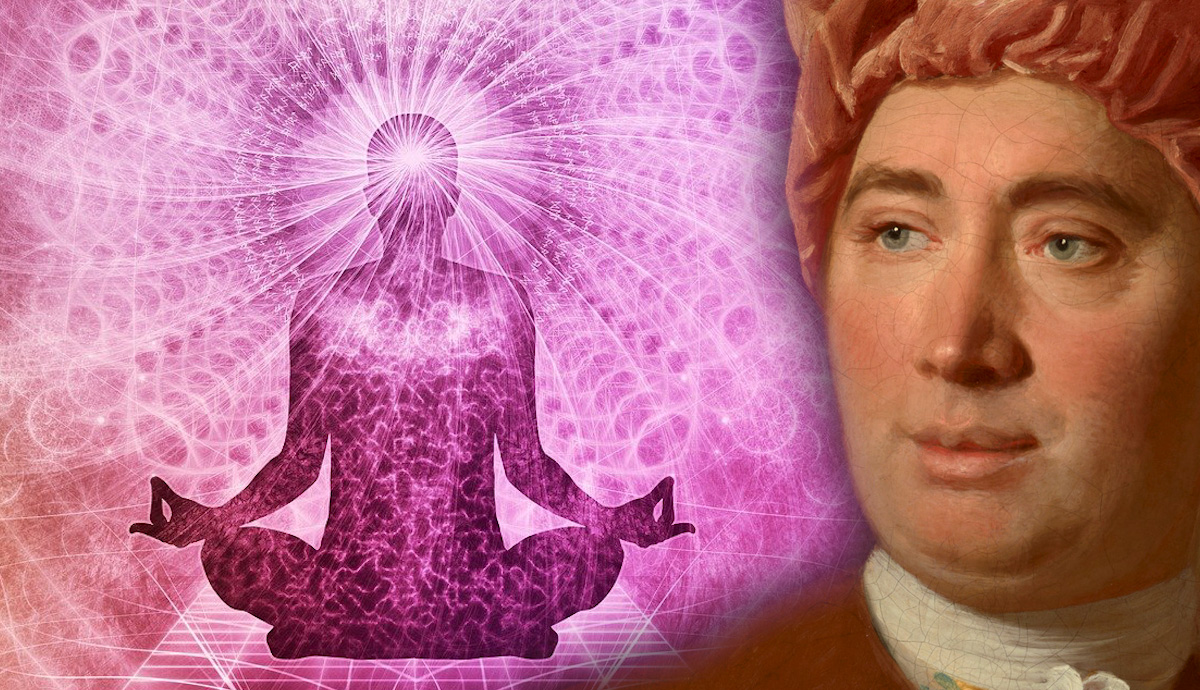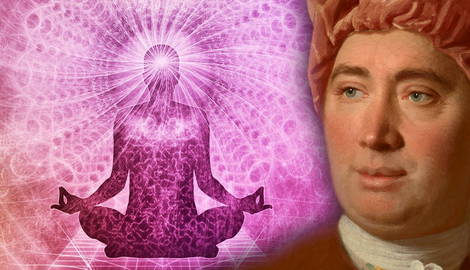
We often refer to our minds and to what we are thinking unselfconsciously, as though it was obvious what we were referring to. However, philosophers have generally found answering the most basic – and therefore the most fundamental – questions about the mind exceptionally challenging. To say what the mind is made up of, what we really mean by terms like ‘thoughts,’ ‘ideas,’ and so on, is extremely difficult. It stretches philosophical inquiry to the boundaries of sense and subjectivity.
David Hume’s approach to these and other related problems has proven both very influential and controversial. This article begins with a discussion of the history of the theory of ideas, before moving on to the distinction between ideas and impressions in Hume’s theory, and finally concluding with a discussion of ‘atomism’ and ‘associationism’ in Hume’s thought.
The Theory of Ideas

The theory of ideas, despite its obvious significance for the success of Hume’s overall philosophical project, is largely taken for granted. Hume himself provides the reasons for his quite limited defense of the theory: it was both almost ubiquitously accepted among the philosophers who preceded him and was, in any case, commonsensical.
As Barry Stroud puts it, the theory of ideas is at one and the same time both appealing and difficult to even state with much precision. It gets its most thorough exposition in Locke, who claims that an idea is ‘whatsoever is the object of understanding when a man thinks.’ This is a broad definition of thinking, including various cognitive faculties (perception, imagination, will, and so on) which we often care to separate from ‘thought’ simpliciter.
To put it one way, ideas are the raw material of thinking. For Locke, we derive our ideas from experience, which falls into the categories of sensation and reflection. Experience, therefore, includes reflection on the internal operations of the mind.
Hume calls objects of the mind perceptions rather than ideas, but it still makes sense to refer to Hume’s theory of ideas in order to locate his thought accurately in the philosophical tradition in which he was submerged, and because the defining concept of Hume’s theory is the ‘idea,’ although the Humean idea is not the same as the Lockean one. For Hume, perceptions (again, which Locke would have called ‘ideas’) fall into two types: impressions and ideas.
Experience and Thought

This division between impressions and ideas roughly tracks the distinction we tend to draw between experience and thought, between perceiving and reasoning or reflecting. However, as much as this distinction makes some intuitive sense, on closer inspection it isn’t easy to say what distinguishes an idea from an impression, and it especially isn’t particularly straightforward to continue to define the idea/impression distinction in a way that tracks closely with the experience/reflection distinction.
Hume distinguishes impressions and ideas according to the ‘degree of force and liveliness,’ with impressions being more forceful and livelier than ideas. In other words, ideas and impressions are qualitatively the same: the difference is a matter of intensity or concentration, not kind.
At first glance, this makes sense: it seems plausible to say, for example, that my memory of what it is like to eat an orange is just a less forceful ‘version’ of my experience of eating an orange. Yet, as Stroud points out, sometimes memories of something can be far more forceful than the original experience of that thing. We might come to interpret our memories in such a way as to ascribe a greater deal of significance to them than we originally experienced.
Imagine a detective who examines a crime scene, observing with only moderate interest a poker set on the left-hand side of a fireplace. Imagine then that the detective finds out that the victim of said crime was right handed, and so would not have naturally placed the poker there themselves. Wouldn’t the idea (memory) of the poker now resonate far more intensely than the original impression did?
Perception

Leaving aside this minor objection, Hume insists that ‘perceptions…are double, and appear both as impressions and ideas’. Therefore, there is a one-to-one relationship between impressions and ideas.
The obvious problem now is that there isn’t a one-to-one relationship between impressions and ideas in practice – I can picture a unicorn in my head even though I’ve never really seen a unicorn. Hume’s solution to this problem is, again, quite straightforward – he proposes a separation between ‘simple ideas’ and ‘complex ideas.’ Simple ideas are those which “admit of no distinction or separation.” Given this, some complex ideas are simply accurate memories of things we have experienced, whereas other complex ideas constitute fantasy.
The notion of indivisibility here nonetheless raises some issues. Should we understand indivisibility as our perception of indivisibility, or as constituting some objective feature of our ideas? In other words, if I can’t ‘break down’ a certain idea into yet more basic component parts, have I ipso facto (by that very fact) located a simple idea?
Hume doesn’t offer us any guidance on this but rather lays down the following challenge: those who doubt his theory ought to ‘show a simple impression, that has not a correspondent idea’ (or visa versa). The point here is that simple ideas can be found to have their origin in an impression, which shows these simple ideas to be the most basic elements of reasoning and reflection, and impressions to be the cause of these processes.
Hume’s Debt to Leibniz

There are a couple of points to note before moving on. First, this element of Hume’s thought shows his indebtedness to previous, early modern philosophers – especially Gottfried Leibniz – for the assumption that complex substances can always be conceived of as unities of simple substances.
Second, empiricism has two faces. There is an element of empiricism that seems prone to the creation of extremely public knowledge: the empirical method is conceived of as progressing from observation to what Hume calls ‘constant conjunctions.’ Hume holds that there is a ‘constant conjunction’ between simple ideas and simple impressions. The term ‘constant conjunction’ is his own, and it simply refers to a tendency that occurs so regularly that it must reflect some underlying structure of reality. We do not – of course – have direct access to the underlying structure of reality, given that all ideas come from impressions, rather than direct contact with reality in itself. Yet, at the same time, the basic units of empirical knowledge are indisputably private and perspectival, grounded (as they are) in our experiences.
Simple and Complex Impressions

Having set out much of Hume’s theory of mind in broad terms, we can begin to both taxonomize and simplify some of Hume’s theses about the mind.
First of all, Hume holds that everything in the mind falls into one of three categories. Either it is an impression, made up of impressions, or comes to be there as a result of simple impressions. There are two kinds of impressions – those of sensation and those of reflection. However, this latter kind of impression exists “downstream” of sensation, given that Hume holds that nothing exists in the mind which is not the consequence of sensation, and there must be something before the mind in order for us to reflect on it.
Stroud characterizes Hume’s theory of mind according to the following eight points, which we can take as a useful summary:
“(1) There is no thought or mental activity unless there is apperception before the mind. (2) every perception is either an impression or an idea. (3) every perception is either simple or complex. (4) ever complex perception consists completely of simple perceptions. (5) for every simple idea there is a corresponding simple impression. (6) every simple idea arises in the mind as the effect of its corresponding simple impression. (7) there are no impressions of reflection with without impressions of sensation. (8) thus, there is no thought or mental activity unless there are impressions of sensation. As we can clearly observe, taking Hume’s theory of mind all at once shows it to constitute a kind of justification for empiricism – the theory that all knowledge is derived from experience.”
Atomism and Association: David Hume’s Positive Theory

However, we can conclude by observing that what we have dealt with in this article primarily constitutes what is known by many modern interpreters of Hume as the ‘atomistic,’ or even the ‘negative’ dimension of Hume’s thought. It is a skeptical project, one accentuated and fixated on by many Anglophonic philosophers when they come to deal with Hume.
Yet there is another element of Hume’s thought, which came to predominate as he refined his theory of mind over time. That is the ‘associationist’ element, which stresses the significance of the operations of the mind and associations between ideas.
While it may be true that all thought can be reduced to a collection of impressions and ideas, it is the very fact that we can call our minds a “collection” that suggests there is a relational component we must explain in more detail in order to understand the workings of our mind.










